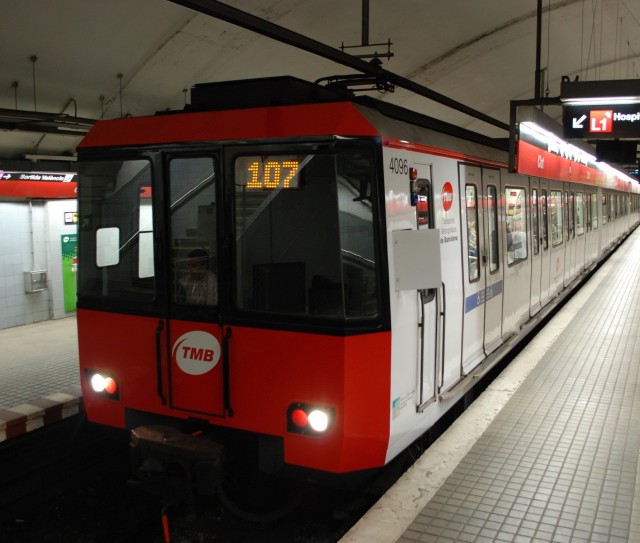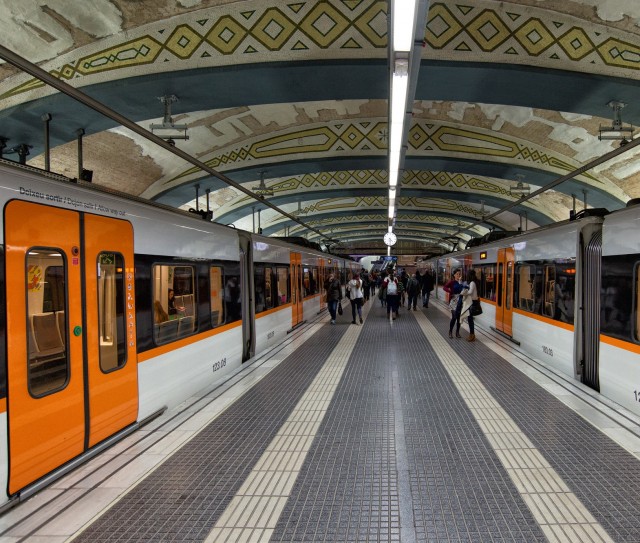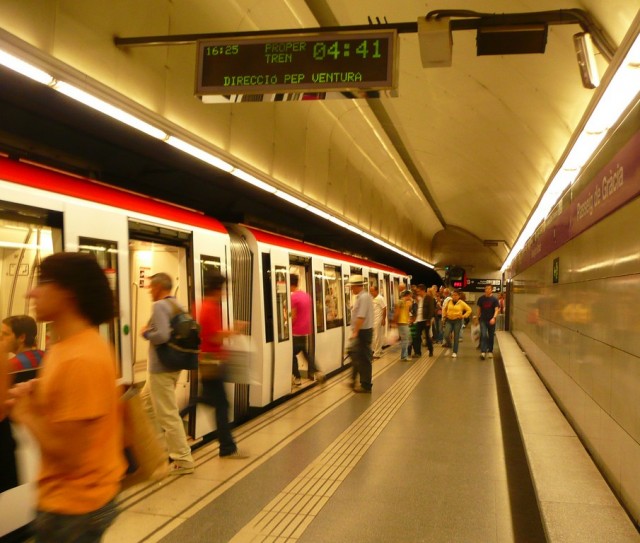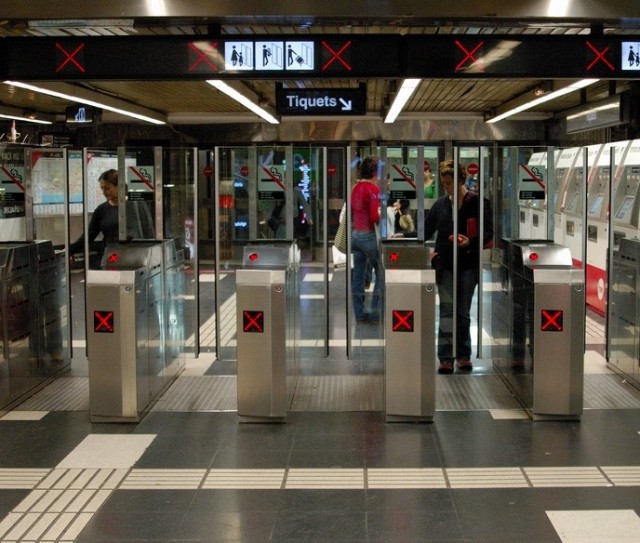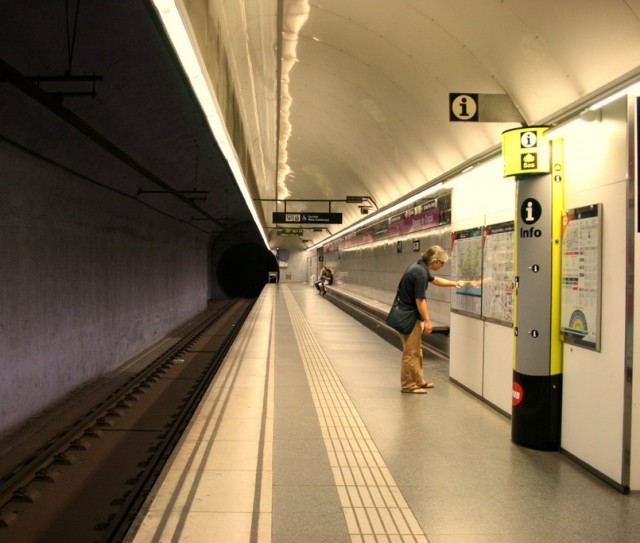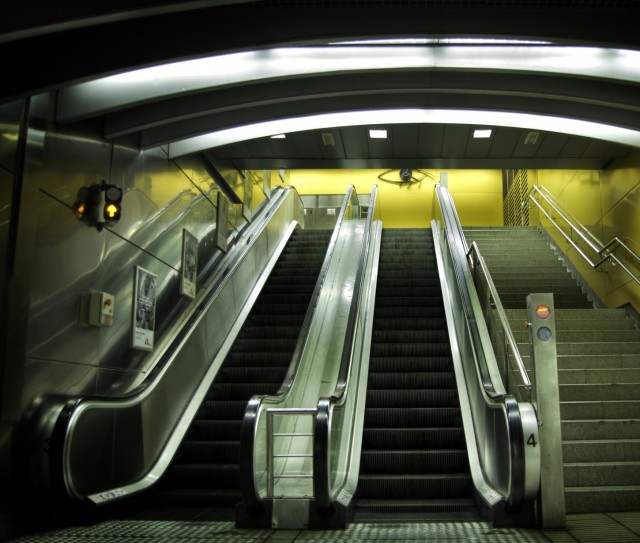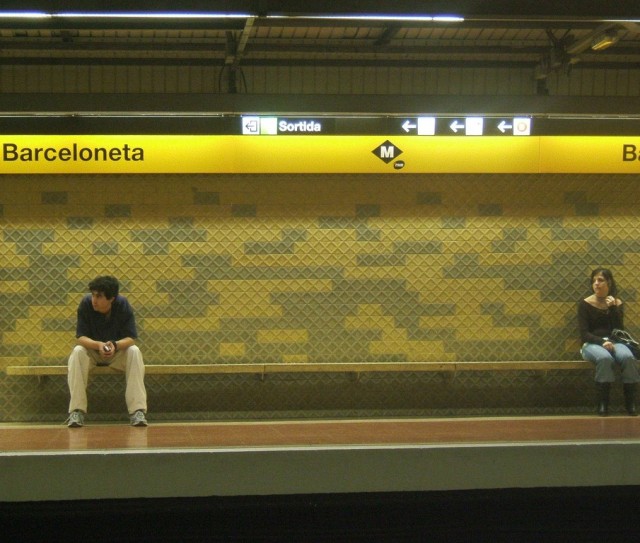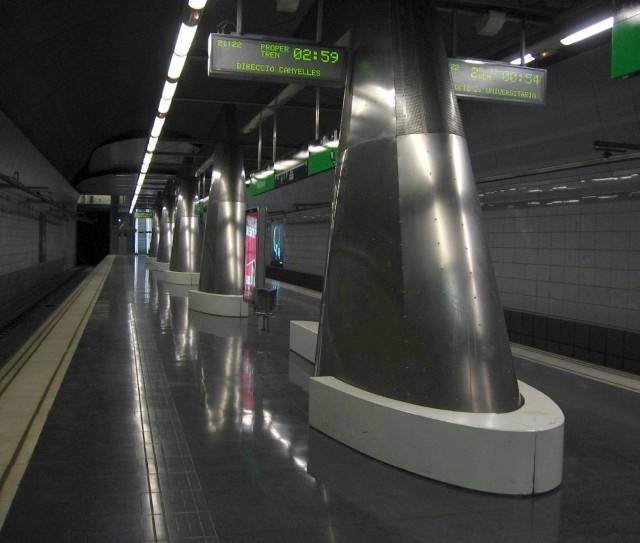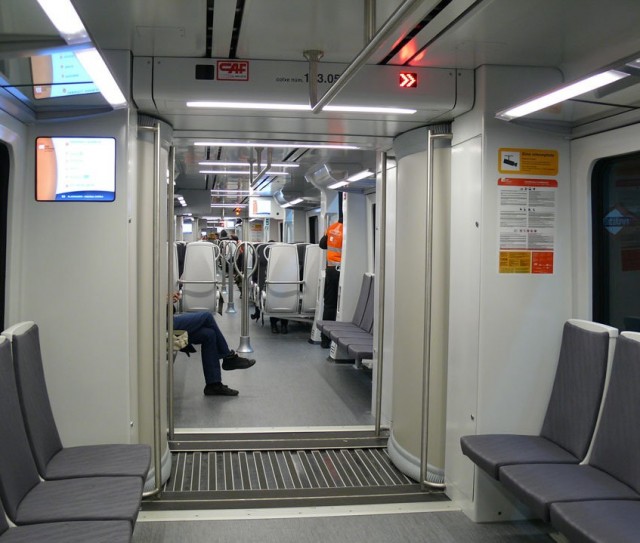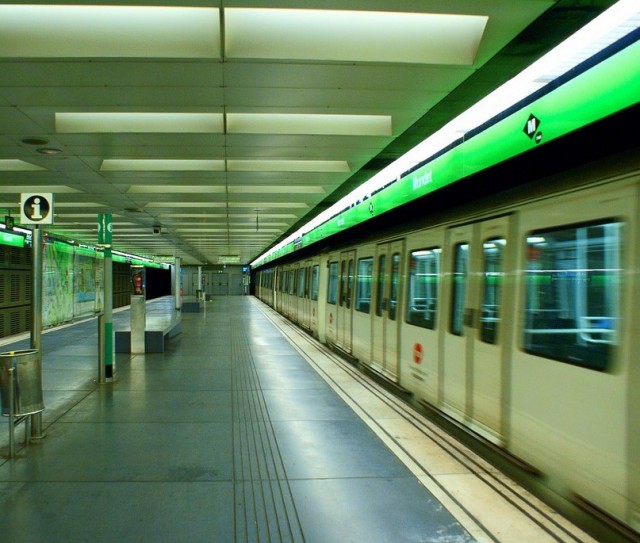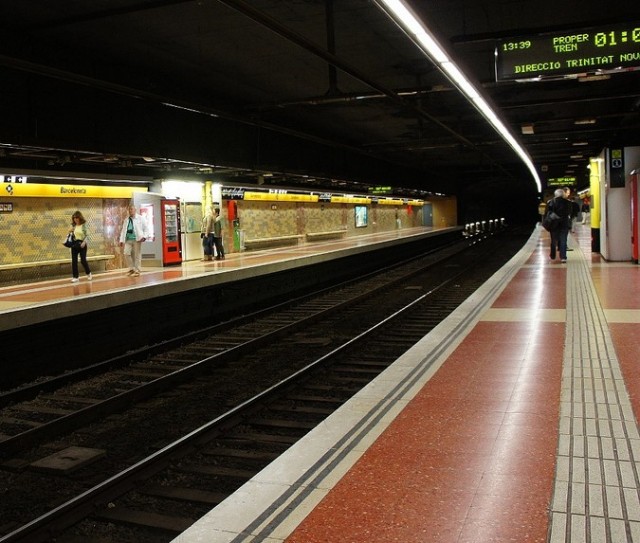- Línia 1
- Hospita de Bellvitge
- Bellvitge
- L'Hospitalet Av. Carrilet
- Rambla Just Oliveras
- Can Serra
- Florida
- Torrassa
- Santa Eulàlia
- Mercat Nou
- Plaça de Sants
- Hostafrancs
- Pl. Espanya
- Rocafort
- Urgell
- Universitat
- Catalunya
- Urquinaona
- Arc de Triomf
- Marina
- Glòries
- Clot
- Navas
- La Sagrera
- Fabra i Puig
- Sant Andreu
- Torras i Bages
- Trinitat Vella
- Baró de Viver
- Santa Coloma
- Fondo
- Línia 2
- Paral•lel
- Sant Antoni
- Universitat
- Passeig de Gràcia
- Tetuan
- Monumental
- Sagrada Família
- Encants
- Clot
- Bac de Roda
- Sant Martí
- La Pau
- Verneda
- Artigues Sant Adrià
- Sant Roc
- Gorg
- Pep Ventura
- Badalona Pompeu Fabra
- Línia 3
- Zona Universitària
- Palau Reial
- Maria Cristina
- Les Corts
- Plaça del Centre
- Sants- Estació
- Tarragona
- Pl. Espanya
- Poble Sec
- Paral•lel
- Drassanes
- Liceu
- Catalunya
- Passeig de Gràcia
- Diagonal
- Fontana
- Lesseps
- Vallcarca
- Penitents
- Vall d'Hebron
- Montbau
- Mundet
- Valldaura
- Canyelles
- Roquetes
- Trinitat Nova
- Línia 4
- Trinitat Nova
- Via Júlia
- Llucmajor
- Maragall
- Guinardó Hospital de Sant Pau
- Alfons X
- Joanic
- Verdaguer
- Girona
- Passeig de Gràcia
- Urquinaona
- Jaume I
- Barceloneta
- Ciutadella Vila Olímpica
- Bogatell
- Llacuna
- Poblenou
- Selva de Mar
- El Maresme Fòrum
- Besòs Mar
- Besòs
- La Pau
- Línia 5
- Cornellà Centre
- Gavarra
- Sant Ildefons
- Can Boixeres
- Can Vidalet
- Pubilla Cases
- Collblanc
- Badal
- Plaça de Sants
- Sants-Estació
- Entença
- Hospital Clínic
- Diagonal
- Verdaguer
- Sagrada Família
- Sant Pau Dos de Maig
- Camp de l'Arpa
- La Sagrera
- Congrés
- Maragall
- Virrei Amat
- Vilapicina
- Horta
- El Carmel
- El Coll la Teixonera
- Vall d'Hebron
- Línia 6
- Reina Elisenda
- Sarrià
- Les Tres Torres
- La Bonanova
- Muntaner
- Sant Gervasi
- Gràcia
- Provença
- Catalunya
- Línia 7
- Avinguda Tibidabo
- El Putxet
- Pàdua
- Plaça Molina
- Gràcia
- Provença
- Catalunya
- Línia 8
- Molí Nou Ciutat Cooperativa
- San Boi
- Cornellà-Riera
- Almeda
- L'Hospitalet Av. Carrilet
- Sant Josep
- Gornal
- Europa Fira
- Ildefons Cerdà
- Magòria la Campana
- Pl. Espanya
- Línia 9 Norte
- La Sagrera
- Onze de Setembre
- Bon Pastor
- Can Peixauet
- Santa Rosa
- Fondo
- Església Major
- Singuerlín
- Can Zam
- Zona Universitaria
- Collblanc
- Torrassa
- Can Tries Gornal
- Europa Fira
- Fira
- Parc Logístic
- Mercabarna
- Les Moreres
- El Prat
- Cèntric
- Parc Nou
- Mas Blau
- Aeroport T2
- Aeroport T1
- Línia 10 Norte
- Gorg
- La Salut
- Llefià
- Bon Pastor
- Onze de Setembre
- La Sagrera
- Collblanc
- Torrassa
- Can Tries Gornal
- Foneria
- Foc
- Zona Franca
- Port Comercial La Factoria
- Ecoparc
- ZAL Riu Vell
- Línia 11
- Trinitat Nova
- Casa de l'Aigua
- Torre Baró Vallbona
- Ciutat Meridiana
- Can Cuiàs
- No matches
- Línia 1
- Hospita de Bellvitge
- Bellvitge
- L'Hospitalet Av. Carrilet
- Rambla Just Oliveras
- Can Serra
- Florida
- Torrassa
- Santa Eulàlia
- Mercat Nou
- Plaça de Sants
- Hostafrancs
- Pl. Espanya
- Rocafort
- Urgell
- Universitat
- Catalunya
- Urquinaona
- Arc de Triomf
- Marina
- Glòries
- Clot
- Navas
- La Sagrera
- Fabra i Puig
- Sant Andreu
- Torras i Bages
- Trinitat Vella
- Baró de Viver
- Santa Coloma
- Fondo
- Línia 2
- Paral•lel
- Sant Antoni
- Universitat
- Passeig de Gràcia
- Tetuan
- Monumental
- Sagrada Família
- Encants
- Clot
- Bac de Roda
- Sant Martí
- La Pau
- Verneda
- Artigues Sant Adrià
- Sant Roc
- Gorg
- Pep Ventura
- Badalona Pompeu Fabra
- Línia 3
- Zona Universitària
- Palau Reial
- Maria Cristina
- Les Corts
- Plaça del Centre
- Sants- Estació
- Tarragona
- Pl. Espanya
- Poble Sec
- Paral•lel
- Drassanes
- Liceu
- Catalunya
- Passeig de Gràcia
- Diagonal
- Fontana
- Lesseps
- Vallcarca
- Penitents
- Vall d'Hebron
- Montbau
- Mundet
- Valldaura
- Canyelles
- Roquetes
- Trinitat Nova
- Línia 4
- Trinitat Nova
- Via Júlia
- Llucmajor
- Maragall
- Guinardó Hospital de Sant Pau
- Alfons X
- Joanic
- Verdaguer
- Girona
- Passeig de Gràcia
- Urquinaona
- Jaume I
- Barceloneta
- Ciutadella Vila Olímpica
- Bogatell
- Llacuna
- Poblenou
- Selva de Mar
- El Maresme Fòrum
- Besòs Mar
- Besòs
- La Pau
- Línia 5
- Cornellà Centre
- Gavarra
- Sant Ildefons
- Can Boixeres
- Can Vidalet
- Pubilla Cases
- Collblanc
- Badal
- Plaça de Sants
- Sants-Estació
- Entença
- Hospital Clínic
- Diagonal
- Verdaguer
- Sagrada Família
- Sant Pau Dos de Maig
- Camp de l'Arpa
- La Sagrera
- Congrés
- Maragall
- Virrei Amat
- Vilapicina
- Horta
- El Carmel
- El Coll la Teixonera
- Vall d'Hebron
- Línia 6
- Reina Elisenda
- Sarrià
- Les Tres Torres
- La Bonanova
- Muntaner
- Sant Gervasi
- Gràcia
- Provença
- Catalunya
- Línia 7
- Avinguda Tibidabo
- El Putxet
- Pàdua
- Plaça Molina
- Gràcia
- Provença
- Catalunya
- Línia 8
- Molí Nou Ciutat Cooperativa
- San Boi
- Cornellà-Riera
- Almeda
- L'Hospitalet Av. Carrilet
- Sant Josep
- Gornal
- Europa Fira
- Ildefons Cerdà
- Magòria la Campana
- Pl. Espanya
- Línia 9 Norte
- La Sagrera
- Onze de Setembre
- Bon Pastor
- Can Peixauet
- Santa Rosa
- Fondo
- Església Major
- Singuerlín
- Can Zam
- Línia 9 Sur
- Zona Universitaria
- Collblanc
- Torrassa
- Can Tries Gornal
- Europa Fira
- Fira
- Parc Logístic
- Mercabarna
- Les Moreres
- El Prat
- Cèntric
- Parc Nou
- Mas Blau
- Aeroport T2
- Aeroport T1
- Línia 10 Norte
- Gorg
- La Salut
- Llefià
- Bon Pastor
- Onze de Setembre
- La Sagrera
- Línia 10 Sur
- Collblanc
- Torrassa
- Can Tries Gornal
- Foneria
- Foc
- Zona Franca
- Port Comercial La Factoria
- Ecoparc
- ZAL Riu Vell
- Línia 11
- Trinitat Nova
- Casa de l'Aigua
- Torre Baró Vallbona
- Ciutat Meridiana
- Can Cuiàs
- No matches
Copyright © 2026 Discover Ukraine LLC.
Info
The Barcelona Metro, inaugurated in 1924, boasts a rich history. Its inaugural line, comprising five stations, linked Plaça Catalunya and Plaça de Lesseps. Over the course of nearly a century, the Barcelona Metro has expanded to encompass eleven lines, the majority of which are subterranean. Presently, the Barcelona Metro stands as the epitome of convenience and speed in the realm of public transportation in Catalonia's capital.
From students and locals to the millions of annual tourists who flock to Barcelona, the Barcelona Metro serves a diverse array of passengers. Adjacent to Barcelona's metro stations lie the city's iconic attractions, including the Arc de Triomphe, Sagrada Familia, Casa Milà, Parque Güell, Picasso Museum, and more. Furthermore, the metro offers direct routes to Barcelona El Prat Airport and the central train station, Estación de Barcelona Sants.
The Barcelona Metro functions under the management of two operators, TMB and FGC, as part of an integrated transport network that includes buses, trams, funiculars, and suburban trains. A metro ticket in Barcelona is priced at 2.40 EUR, entitling passengers to 1 hour and 15 minutes of travel across all modes of public transport. For frequent travelers or groups, the T-casual ticket at 11.35 EUR proves to be a cost-effective option, allowing for 10 trips that can be shared among multiple individuals at the same station.
Identification of Barcelona metro stations is marked by a red diamond featuring an M for TMB or an orange rectangle adorned with two white brackets for FGC. Beneath these markers, station diagrams depict the Barcelona metro layout and the lines serviced by each station. Inside, all Barcelona Underground stations house three platforms, offering passengers the convenience of embarking and disembarking from both sides of the train, minimizing congestion and enhancing efficiency. This unique station design is referred to as the "Barcelona solution."
The Barcelona metro accommodates a mix of modern and vintage trains. The latter are outfitted with specialized buttons or levers to facilitate door operation. An aspect that warrants consideration is the connections between stations, which, unfortunately, tend to be narrow, lengthy, and occasionally cramped, detracting from an otherwise seamless travel experience.
Lines
The Barcelona Metro consists of 11 lines of different colour and number: L1 (red), L2 (violet), L3 (green), L4 (yellow), L5 (dark blue), L6 (purple), L7 (brown), L8 (pink), L9 (orange), L10 (sky blue), L11 (light green). Stations are conveniently located both in the touristic city centre and remote districts. Metro lines length amounts to 144,3 km and has 180 stations. Working hours: from 5 a.m. till midnight (Sunday – Thursday) and from 5 a.m. till 2 a.m. (Fridays and holidays). Moreover, the metro runs all night on Saturdays.
Fare
The cost of a single ticket makes € 2.40. In addition, there are various transport cards: the most popular one is T-casual giving you the right for 10 journeys and making them twice cheaper – €11,35. Also, there is an unlimited travel ticket: for 48 hours – € 16,30 for 72 hours – € 23,70, for 96 hours – € 30.80, for 120 hours – € 38, for 1 month – € 40.
Ticketing
Tickets and transport cards can be purchased from ticket machines and ticket offices located at the stations. You can pay in cash or with a bank card. Stations are entered through ticket barriers. The ticket shall be kept until the end of the journey. Be attentive when choosing the platform.
 English
English Deutsch
Deutsch Français
Français Italiano
Italiano Español
Español Português
Português Русский
Русский Українська
Українська Polski
Polski Čeština
Čeština Ελληνικά
Ελληνικά Türkçe
Türkçe Tiếng Việt
Tiếng Việt ไทย
ไทย 日本語
日本語 中文
中文 한국어
한국어